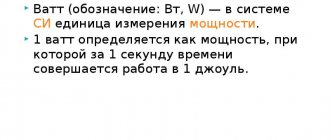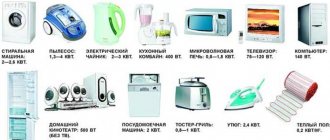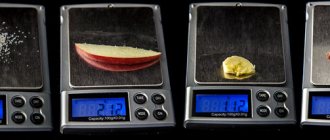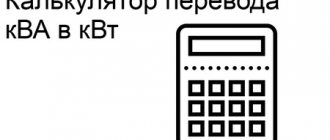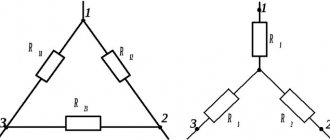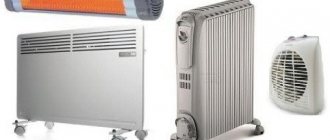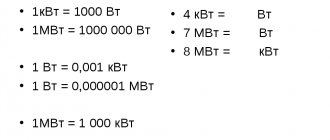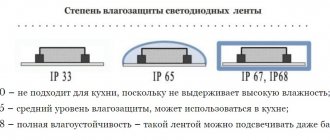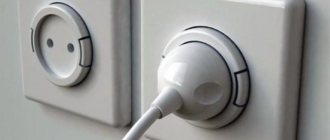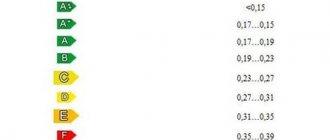Watt and kilowatt - what is it?
The watt is a measurement unit of power, as well as heat flux in physics, sound electrical energy flux, direct current power, active and apparent electric current power, radiation flux and ionizing radiation energy flux in the international measuring system. It is worth pointing out that this is a scalar measurement quantity, that is, measured and calculated.
Description from the reference book
To make it convenient to use watts, the international system has adopted the use of prefixes that determine the decimal multiple of the original indicator. As a rule, kilowatt is used for it. Translated from Greek, the prefix kilo means thousand. The use of a prefix means an increase in the original value by 103 times.
Note! KWh is a non-systemic unit of measurement that shows when energy is produced or consumed and in what quantity. It also shows mechanical work done and heat. Used to measure household electrical energy consumption or measure electrical energy production in the energy sector.
How many volts does 1 ampere contain?
As in the previous example, such questions are asked incorrectly. Converting voltage to current is possible only taking into account:
- electrical resistance of the circuit section;
- power;
- load characteristics;
- constant (variable) parameters of the power supply network.
However, it should be noted that in the Russian Federation, along with the international standard (SI), the non-system unit “Volt-ampere” is used. Its value is equal to 1 W of power, so there is no need to convert using additional coefficients. In this case we are talking about power supply with a sinusoidal signal in a single-phase network.
Volt-amp power refers to the total energy of the power source that is consumed per hour. Measure the actual voltage values at the generator terminals and the current in the connected circuit. This means that in real conditions some of the energy will be wasted on:
- thermal heating;
- electromagnetic oscillations created by reactive components.
How to correctly convert these units
A watt is equal to a kilogram multiplied by square meters and divided by cubic seconds. The prefix kilo denotes multiplication by 1000. The same principle applies to power indicators, that is, 1 kW contains 1000 W and 1000 volts. This means that 1 unit = 0.001 subunits. That is, if you convert the power, then a 3 kW electrical appliance will be equal to 3000 W.
You might be interested in what power is the 16a machine designed for?
Conversion formula
In electricity
To simplify measurements in electricity, a subunit is used. You can find out how many watts are in a kilowatt and convert the units by multiplying watts by 103 and dividing by 1000. To carry out the reverse conversion, you need to multiply kW by 103 or multiply known indicators by 1000.
Quantities in electricity
In heating
To measure thermal power, you need to use the joule. This is the work done by 1 newton per 1 meter. To convert joule to kW, you need to use the joule subunit. There are 0.239 kcal in 1 kJ. There are 4.1868 kJ in 1 kcal. There are 860 kcal in 1 kW. This means that 1000 kcal contains 1.163 kW per hour.
Heating measurements
Converter
To calculate the values, you can use an easy-to-use converter. Converter is a system that converts source data into a given value. All the user needs to do is paste the available data into the field and press the start button on the service being used.
Note! There are different system converters. Some convert these watts, and some directly into kilowatts.
Convector
GHS and non-systemic units
| kilowatt to gigacalorie per second |
| kilowatt to kilocalorie per second |
| kilowatt to calories per second |
| kilowatt to gigacalorie per minute |
| kilowatt to kilocalorie per minute |
| kilowatt to calories per minute |
| kilowatt to gigacalorie per hour |
| kilowatt to kilocalorie per hour |
| kilowatt to calories per hour |
| kilowatt to boiler horsepower (hp(S)) |
| kilowatt to electric horsepower (hp(E)) |
| kilowatt to hydraulic horsepower |
| kilowatt to mechanical horsepower (hp(I)) |
| kilowatt to metric horsepower (hp(M)) |
| kilowatt to kilogram-force meter per second (kgf*m/s) |
| kilowatt to joule per second |
| kilowatt to joule per minute |
| kilowatt to joule per hour |
| kilowatt to erg per second |
| kilowatt to metric refrigeration ton (RT) |
| kilowatt to frigoria per hour (fg/h) |
Units: gigacalories per second / kilocalories per second / calories per second / gigacalories per minute / kilocalories per minute / calories per minute / gigacalories per hour / kilocalories per hour / calories per hour / boiler horsepower (hp(S)) / electric horsepower power (hp(E)) / hydraulic horsepower / mechanical horsepower (hp(I)) / metric horsepower (hp(M)) / kilogram-force meter per second (kgf*m/s) / joule per second / joule per minute / joule per hour / erg per second / metric refrigeration ton (RT) / frigoria per hour (fg/h) » open »» collapse »
British and American units
| kilowatt to American refrigeration ton (USRT) |
| kilowatt to British thermal unit per second (BTU/s) |
| kilowatt to British thermal unit per minute (BTU/min) |
| kilowatt to British thermal unit per hour (BTU/hr) |
| kilowatt to foot pound-force per second (ft*lbf/s) |
Units: US refrigeration ton (USRT) / British thermal unit per second (BTU/s) / British thermal unit per minute (BTU/min) / British thermal unit per hour (BTU/hr) / foot pound-force per second (ft *lbf/s) » open »» collapse »
Conversion table for watt to kilowatt
The measured values presented in the table below will help you calculate the energy used by a specific device and make other mathematical calculations in the electrical field.
Table
In general, a kilowatt is a sub-quantity of a watt, the symbol for power. You can correctly convert W to kW in electricity and heating using the conversion formula, table and special online calculator.
Tables of ratios of amperes, volts, watts, ohms
To simplify, the main parameters of the electrical circuit are explained using the example of the functioning of a conventional pipeline. The movement of fluid is ensured by the pressure difference. The narrowing (expansion) of the transport route changes the flow resistance accordingly. If necessary, using the listed parameters or experimentally, you can set the pipeline productivity in liters per unit of time.
By analogy with the above description, the potential difference (voltage) ensures the movement of electric charges (current). As the cross-section of the conductor decreases, the electrical resistance increases. Knowing the basic parameters, it is easy to calculate the power consumption of the connected load.
Table for calculating the comfort zone of “electronic” cigarettes
The specified power data corresponds to certain resistance and voltage values. Similar tables are compiled for converting Watts into amperes and other quantities. This example clearly demonstrates the main disadvantages of the tabular form:
- complexity of processing large amounts of data;
- discreteness of information provision;
- limited accuracy.
Graphical representation of basic formulas for calculating electrical parameters
Using calculations, you can convert volts to amperes quickly and accurately.
For your information. As an alternative, an electrical quantity converter is used, which is available for free use on reference and specialized websites on the Internet.
The difference between kilowatt and kilowatt∙hour
In electrical engineering there is a quantity called kilowatt∙hour, which is measured by electric meters. Many people substitute concepts, not seeing the difference between the definitions of “kilowatt” and “kilowatt∙hour”, considering the quantities to be one parameter.
Despite the similarity of names, these are completely different quantities. Kilowatt hour is used to measure the amount of electrical energy produced or consumed per unit of time. In particular, the consumption of an electrical receiver of 1 kW∙hour denotes the energy consumed by a consumer with a power of 1 kW for 1 hour. In contrast, a kilowatt is a unit of power that denotes the intensity of generation or consumption of electricity.
Example: A recessed LED luminaire is equipped with a 35 W LED lamp. For 1 hour of operation it consumes 35 Wh of electricity, for 2 hours, respectively, 2x35 = 70 Wh. With continuous operation for 5 days/120 hours, the electricity consumption of the lamp will be 35x120=4200 W∙hour or 4.2 kW∙hour.
Notes[edit]
- Energy when climbing stairs comes from mgh
.
Setting m
= 100 kg,
g
= 9.8 m/s2 and
h
= 3 m gives 2940 J. Dividing this by the time taken (5 s) gives a power of 588 W. - The average household electricity consumption is 1.19 kW in the US and 0.53 kW in the UK. In India it is 0.13 kW (urban) and 0.03 kW (rural) - calculated based on GJ data given by Nakagami, Murakoshi and Iwafune. [16]
- Watts per hour would properly refer to the rate of change
of power used (or generated). Watts per hour can be useful for characterizing the ramp-up of power plants or slow-responding power plants where their output can only change slowly. For example, a power plant that changes its power output from 1 MW to 2 MW in 15 minutes will have a slew rate of 4 MW/h.
Relation to base and multiple units of power
Watt refers to a derived unit of power, so in practice it is sometimes necessary to determine the value of the parameter in relation to the basic units of the international SI system. In technical calculations, the following correspondences to the basic quantities are used:
- W = kgm²/s³;
- W = Hm/s;
- W = VA.
The parameter has universal application and is equally used in technical developments in a wide variety of fields.
In heat engineering, a unit of measurement of thermal power of 1 cal/hour, which is not included in the international SI system, is used. Our value under consideration is related to it by the ratio: 1 W = 859.85 cal/hour.
Often, for the convenience of handling large amounts of power from power plants and power units, the word watt can be used with the prefixes “mega” or “giga”:
- megawatt is denoted MW/MW and corresponds to 106W;
- gigawatt (abbreviated GW/GW) is equal to 109W.
On the contrary, in low-current information networks, electronic gadgets and modern electronic equipment, power is measured in fractions of a watt:
- milliwatt (mW, mW) is 10-3 W;
- microwatt (μW, µW) equals 10-6 W.
Using these relationships, you can always convert most parameters into the required power units.
Links[edit]
- Bureau International des poids et mesures, International System of Units (SI) / International System of Units (SI)
, 9th ed. (Sèvres: 2019), ISBN 978‑92‑822‑2272‑0, §2.3.4, table 4. - Yildiz, I.; Liu, Y. (2018). "Energy Units, Conversions and Dimensional Analysis". In Dincer, I. (ed.). Integrated energy systems.
Volume 1: Fundamentals of Energy . Elsevier. pp. 12–13. ISBN 9780128149256. - International Bureau of Weights and Measures (2006), International System of Units (SI)
(PDF) (8th ed.), Pp. 118, 144, ISBN 92-822-2213-6, archived (PDF) from the original on 2017-08-14 - Avallone, Eugene A; et al., eds. (2007), Mark's Standard Handbook for Mechanical Engineers
(11th ed.), New York: Mc-Graw Hill, pp. 9–4, ISBN 978-0-07-142867-5. - ^ a b c
Klein, Herbert Arthur (1988) [1974].
The Science of Measurement: A Historical Review
. New York: Dover. item 239. ISBN. 9780486144979. - "Address of C. William Siemens". Report of the fifty-second meeting of the British Association for the Advancement of Science
. London: John Murray. 1883. pp. 1–33. - Siemens supported his proposal, saying that Watt was the first who "had a clear physical idea of power and gave a rational method of measuring it." "Siemens, 1883, p. 6"
- "Siemens", 1883, p. 5 "
- Jump up
↑ Tunbridge, P. (1992).
Lord Kelvin: His Influence on Electrical Measurements and Units
. Peter Peregrinus: London. paragraph 51. ISBN 0-86341-237-8. - ^ a b
"Units, physical."
Encyclopedia Britannica
.
27
(11th ed.). 1911. p. 742. - "Resolution 12 of the 11th CGPM (1960)". International Bureau of Poids et Mesures (BIPM)
. Retrieved April 9, 2022. - Jump up
↑ Ainslie, M. A. (2015). The Age of Sonar: Planetary Oceanography, Underwater Noise Monitoring, and Underwater Sound Terminology. Acoustics today. - Morpheus, C. L. (2001). Dictionary of acoustics.
- "Bye-Bye Batteries: Radio Waves as a low-power source", The New York Times
, July 18, 2010, archived from the original on March 21, 2017. - Stetzler, Trudy; Magotra, Neeraj; Gelabert, Pedro; Kasturi, Preeti; Bangalore, Sridevi. "A platform for the development of low-power, real-time programmable digital signal processors for digital hearing aids". Data archive. Archived from the original on March 3, 2011. Retrieved February 8, 2010.
- Nakagami, Hidetoshi; Murakoshi, Chiharu; Iwafune, Yumiko (2008). International comparison of household energy consumption and its indicator
(PDF). ACEEE Summer Study on Energy Efficiency in Buildings. Pacific Grove, CA: American Council for an Energy Efficient Economy. Figure 3. Energy consumption per household by fuel type. 8:214–8:224. Archived January 9, 2015 (PDF). Retrieved February 14, 2013. - Elena Papadopoulou, Photovoltaic Industrial Systems: An Environmental Approach
Springer 2011 ISBN 3642163017, p.153 - "Information Digest 2007–2008, Appendix A" (PDF). Nuclear Regulatory Commission. 2007. Archived (PDF) from the original on February 16, 2008. Retrieved January 27, 2008.
- Bai, Jim; Chen, Aizhu (November 11, 2010). Lewis, Chris (ed.). "China's Shanxi province to face 5-6 GW power shortage by end of year - paper". Beijing: Reuters.
- "Not on my beach please". Economist
. August 19, 2010. Archived August 24, 2010. - "Chiffres clés" [key numbers]. Electrabel
. Who we are: Nuclear (in French). 2011. Archived from the original on 2011-07-10. - Davidson, CC; Preedy, R. M.; Cao, J; Zhou, C; Fu, J. (October 2010), "Ultra-High Power Thyristor Valves for HVDC in Developing Countries", 9th International AC/DC Power Transmission Conference
, London: IET. - "Crossing the Petawatt Threshold". Livermore, California: Livermore National Laboratory. Lawrence. Archived from the original on September 15, 2012. Retrieved June 19, 2012.
- The world's most powerful laser: 2,000 trillion watts. What is this?
, IFL Science, archived from the original on 08/22/2015.. - Eureka Alert
(publicity release), August 2015, archived from the original on 2015-08-08. - "Construction of a composite time series of total solar irradiance (TSI) from 1978 to the present". : PMODWRC. Archived from the original on August 22, 2011. Retrieved October 5, 2005.
- Rowlett, Russ. "How many? Dictionary of units of measurement. M" University of North Carolina at Chapel Hill. Archived from the original on August 22, 2011. Retrieved March 4, 2022.
- Jump up
↑ Cleveland, C. J. (2007).
"Watt". Encyclopedia of the Earth
. - "Solar Energy Grows at Record Pace in 2008 (EERE Network News Excerpt." US: Department of Energy). March 25, 2009 Archived October 18, 2011
- International Bureau of Weights and Measures (2006), International System of Units (SI)
(PDF) (8th ed.), Pp. 132, ISBN 92-822-2213-6, archived (PDF) from the original on 08/2017/14 - “ Avedøre Avedøre værket
. DONG Energy. Archived from the original on 2014-03-17. Retrieved March 17, 2014. - "Selecting an inverter". Wind and sun of Northern Arizona. Archived from the original on May 1, 2009. Retrieved March 27, 2009.
How to calculate the total power of household appliances
The installed power of a house or cottage is important when calculating and selecting electrical wiring and machines. Without this parameter it is impossible to design the power supply of the house.
To find out the installed power, you need to select data on power consumption from the equipment passports. For example, as indicated on the plate.
| Name | Power, W |
| TV | 150 |
| Boiler | 1 500 |
| Electric furnace | 2 000 |
| Washing machine | |
| Fixtures (total number of light bulbs in the entire house) | 1 000 |
| Computer | 100 |
| TOTAL: | 3,750 W or 3.75 kW |
To correctly calculate the power supply of a house, the combination coefficient is taken into account. It indicates how many consumers are working simultaneously.
For installed power in a house, cottage, apartment up to 14 kW, a coefficient of 0.8 is used in the calculations. That is, the total value of the loads is taken and multiplied by 0.8. For our example, in the calculations we take a power equal to 3.75 * 0.8 = 3 kW.
What is a decibel milliwatt (dBm)? Why do we need dBm?
By taking the reference value as the “zero level” and comparing a specific value with it, you can significantly simplify the recording and operate with small, easy-to-read numbers.
Most often, this notation is used for units of power - milliwatts. Taking the value of 1 mW as the reference level, we get a new unit - decibel-milliwatt (dBm).
dBm indicates how many times a given power value is greater (or less) than 1 mW . The decibel-milliwatt value can be either positive (for power >1 dB) or negative (for power <1 dB).
0 dBm = 1 mW
10log10(mW) = dBm
10(dBm / 10) = mW
At first glance, using decibel milliwatts may seem overly complicated, but in practice, using this unit makes it easier to work with large and small values. Decibels, milliwatts and decibels can be added and subtracted using simple arithmetic operations, and writing and numerical expressions take much less space and time.
Let's give a simple example. Let's say that the original signal with a power of 17 dBm, when propagating in free space, is “attenuated” by 80 dB. Then:
20 dBm − 80 dB = -60 dBm
For a classic notation in “times”, such an entry would look like this:
100 mW / 100,000,000 times = 0.000001 mW
Obviously, writing in relative units is much more convenient and practical than writing completely in “times”.
Converting watts to kW
For example, on the iron it says 2000 Watt (W) this means 2 kW, another example with a 100 watt light bulb when converted to kW we get 0.1 kW, therefore:
1 kW = 1000 Watts
By analogy, other meanings can be translated:
You can also convert 1, 2, 3, 4, 5, 6, 7, 8 kW, etc. to watts:
Power(Watt)Power(kW)
| 1000 | 1 |
| 2000 | 2 |
| 3000 | 3 |
| 4000 | 4 |
| 5000 | 5 |
| 6000 | 6 |
| 7000 | 7 |
| 8000 | 8 |
CONTENT
- 1 Overview 1.1 Examples
- 3.1 Attowatt
